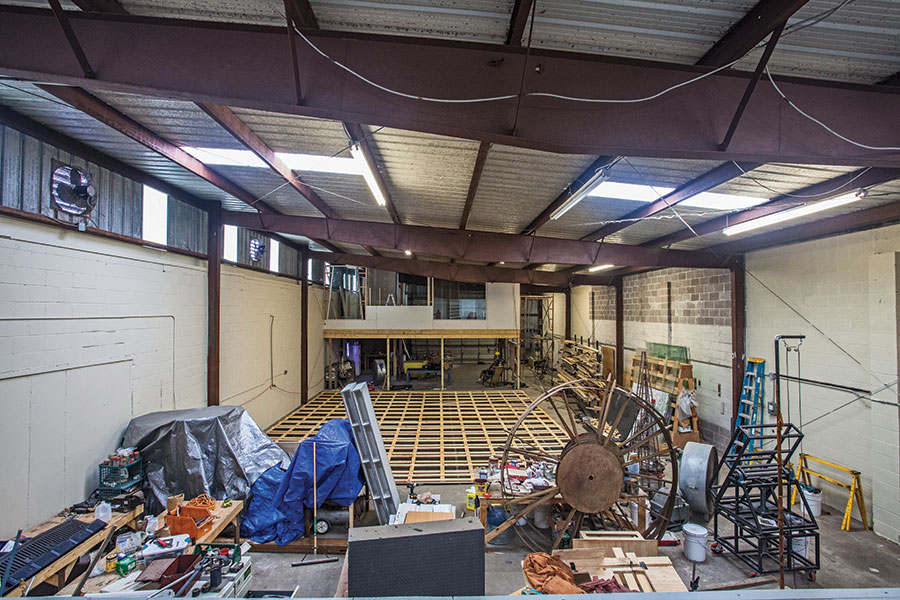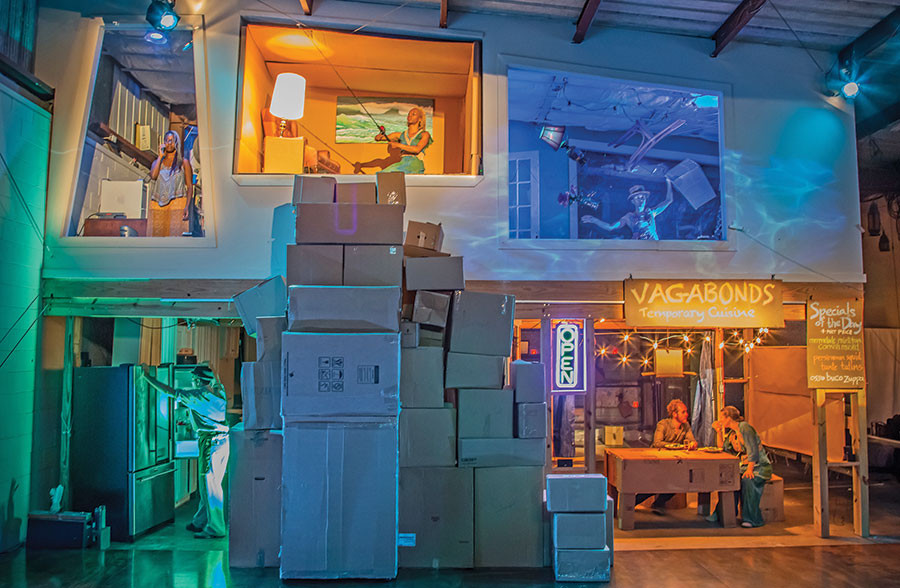CHALLENGE
To nurture creativity and innovation in theatrical design via a collaborative workspace solution
SOLUTION
Join forces to establish an expansive, multipurpose design studio that can house member companies and serve as a development and performance space
WHAT WORKED
Design became more integral to productions; collaboration and artistic interaction flourished
WHAT DIDN’T
Scarcity of funding and dependence on sweat equity means progress can be slow
WHAT’S NEXT
Bring laboratory model of design, rehearsal, training, and resource-sharing to other cities
Water, water everywhere. It was flowing in blue waves across video screens, undulating across walls and floors in animated projections, even (in a startling illusion) appearing to fill a cloudily lit glass-walled office space right up to the rafters, turning the room’s three human inhabitants into slow-motion sea creatures. All that surging water was the key ingredient in Sea of Common Catastrophe, a work-in-progress staged this past May by New Orleans’s ArtSpot Productions and scheduled to tour widely across the U.S. next season.
The show—as well as its initial venue, a 4,000-square-foot warehouse workspace known as Catapult, situated in the city’s Marigny district just a stone’s throw from the rushing currents of the Mississippi River—is the brainchild of award-winning visual artist and set designer Jeff Becker. Sea of Common Catastrophe had been burbling in Becker’s imagination for nearly two decades, but it was only after he engineered the establishment of Catapult and set the building’s collaborative gears in motion that the production itself was able to spring to life.

Catapult’s clunky concrete exterior—embellished along its Chartres Street side by local artist Laurel True’s swirling, mirrored mosaics—gives little hint of the interior’s organizational sophistication. The 53-year-old Becker calls it “a collective performance laboratory dedicated to nurturing design-driven performance.” It has served as home base since late 2012 not only for ArtSpot but also for two other accomplished New Orleans ensembles with which Becker is associated, New Noise and Mondo Bizarro—“the original gangsters who put in money, time, and sweat” on the project, as Becker puts it. The three core companies share an elevated, open-plan office space as well as storage facilities in the building, whose central feature is a 900-square-foot sprung wood floor suitable for dance as well as theatre. Walls are scarce; everybody working in Catapult can see what everybody else is doing. “We had already worked together collaboratively, so it was not so much a stretch to share a space,” Becker says.
Besides productions, Catapult also presents weekly training sessions hosted by Mondo Bizarro and New Noise’s Sound Off!, an annual festival of new work (its last iteration ran June 2-4). An array of local dance and theatre troupes—including Goat in the Road, Skin Horse Theater, and Lux et Umbra ensemble—have begun to use Catapult regularly for rehearsals and production development as well. What all of the companies are participating in, Becker explains, is “design-driven dramaturgy.”
“A lot of companies don’t bring the design world into the work early enough—not because they don’t want to but because the space and time aren’t set up for that,” Becker elaborates. “It’s important to me as a designer, director, and visual artist that the design of a show has the same weight as text, that design is brought in at the get-go. For me, the space in which a show happens is a character—it needs to live and grow and unfold in the same way a character does.”
But early integration of design is just one plus in Catapult’s tally of theatrical assets, as Becker indicates during a conversation in the building’s compact but congenial kitchen space during Common Catastrophe’s opening weekend run.
“My dream was always to be part of a collective studio space, but in theatre that model isn’t really present,” he explains. Then in 2009, while he was a teacher at New Orleans Center for the Creative Arts, the city’s well-resourced performing arts high school, he spotted an old building across the street. “Something clicked. It was a laundromat, an ugly warehouse building full of toxic chemicals and old machines. I formed an LLC and bought it and held on to it, renting it out until I could put together a business plan to bring other artists there to work, make it affordable, and so on.”
By 2012 the laundromat had vacated the building, and after a stint renting it to a special-effects film group, Becker and his arts team rolled up their sleeves: The rehearsal floor was installed, offices crafted, storage spaces delineated, a kitchen and bathroom with shower added (“so nobody ever really had to leave!”). Eventually the three companies moved their entire facilities there—it was cheaper and more flexible than operating independently. Efficiency proved to be only one of Catapult’s benefits.
Cross-pollination was another. “The difference working here is the accidental information you start to receive about other people’s processes and ways of working,” testifies Mondo Bizarro’s artistic director, Nick Slie. “You go, ‘Hey, tell me about that!’ It opens up things for you. The collective unconscious tends to play out when you have access to artists you might otherwise never get close to. Those unplanned meetings, unexpected collisions, are what’s important.”
In addition to locals, Slie and other Catapult regulars have mixed it up with members of such visiting troupes as Massachusetts’s farm-based Double Edge Theatre, Pennsylvania’s Pig Iron Theatre Company, and most recently Grenland Friteater of Norway.

Sea of Common Catastrophe, billed as “a new touring show about displacement, detritus, and designer food,” is the anchor of ArtSpot’s 20th-anniversary season and the first full-scale production to occupy Catapult. The occupation is total: The staging stretches from the building’s roof to its interior nooks and crannies, showcasing a trio of principal performers—longtime N.O. actor and co-conceiver of Catapult Lisa Shattuck, ArtSpot artistic director Kathy Randels, and lithe dancer Kehinde Ishangi—and conjuring its watery effects via Courtney Egan’s video design and Evan Spigelman’s kaleidoscopic lighting. Advance press mentioned the show’s debt to Gabriel García Márquez’s resonant short story “Sea of Lost Time,” but might audiences perceive it mainly as another post-Hurricane Katrina play?
“Actually, the idea of being underwater—of history and the past being submerged—first came from a trip to China” that Becker made with Shattuck in 1995. That was prior to the construction of Three Gorges Dam, which flooded hundreds of villages and displaced more than a million people.
“The idea that these 1,000-year-old villages were going to completely disappear was intriguing to me,” Becker says. “Later I read the García Márquez story about a town that gets submerged, but life there persists. That’s the connection to Katrina—flooding as a metaphor for change, for wiping the slate clean and starting fresh, and what’s forgotten or left behind in the process of gentrification and renewal.”
How, though, can a show so clearly made to order for Catapult’s distinctive geography adapt to touring? Becker is not worried. “Presenters who have booked the show don’t believe I can make it work, but I’m going to prove them wrong.”
What’s next for Catapult? “Climate control,” Becker deadpans. The building’s office rooms have it, but the large performance space under Catapult’s metal roof needs cooling in the city’s sizzling summer and heating in its sometimes chilly winter months. Money is still tight, but Becker isn’t going to let that slow down his momentum.
“My dream now,” he says, updating his aspirations, “is to start places like this not just in New Orleans but in arts communities across the country, so we can be doing shared residencies, bringing people to town and vice versa. Imagine a network of sacred performance spaces that serve many purposes, from family dinners to serious personal work, from community discussions to workshops, classes, yoga—whatever the community needs. We need to be open to anything and everything.”
Jim O’Quinn, founding editor of this magazine, now lives in New Orleans.


